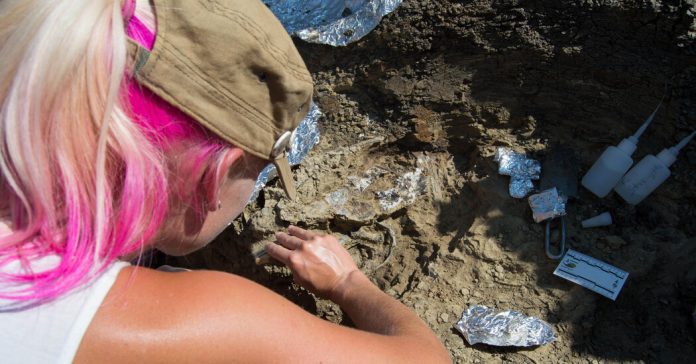The dinosaur-killing meteor hit in spring.
That’s the conclusion of scientists who examined the bones of fish that died on that day when a six-mile-wide asteroid collided with Earth.
“These fishes died in spring,” mentioned Melanie Throughout, a graduate pupil at Uppsala College in Sweden and lead writer of a paper revealed on Wednesday within the journal Nature. “The reign of dinosaurs led to spring.”
Scientists have recognized when the meteor hit — simply over 66 million years in the past, give or take 11,000 years — and the place it hit, off the Yucatán Peninsula of Mexico. That ended the Cretaceous interval of Earth’s geological historical past, however though three-quarters or extra of the species of vegetation and animals disappeared within the mass extinction that adopted, it has been arduous to pinpoint fossils of something immediately killed by the meteor.
However in 2019, paleontologists revealed the invention in southwestern North Dakota of what gave the impression to be a mass graveyard of creatures that died hours or days after the affect. Though North Dakota was about 2,000 miles from the place the meteor hit, the seismic waves of what was the equal of an earthquake with a magnitude of 10 or 11 sloshed water out of the lakes and rivers and killed the fish. Tektites — small glass beads propelled into the air by the affect — rained from the skies.
The researchers spent years exploring the location, often known as Tanis, which is within the fossil-rich Hell Creek formation that stretches throughout 4 states. An article in The New Yorker described Tanis as a wonderland of fossil finds; the preliminary scientific paper describing the location was extra sparse on particulars, specializing in the geological setting.
With the brand new science outcomes, the fossils now present perception into the cataclysm that was beforehand unattainable to discern.
“It’s superb that we will take an occasion, a single second that occurred 66 million years in the past — actually a rock falling down and straight away hanging the Earth — and we will pinpoint that occasion to a specific time of the 12 months,” mentioned Stephen L. Brusatte, a paleontologist on the College of Edinburgh who was not concerned within the analysis. “I believe it’s a detective story of the best caliber.”
Animals within the Northern Hemisphere — some rising from hibernation or giving delivery to younger — may need been extra susceptible to extinction. “If it was spring, then it was not very possible for a lot of organisms to be in hibernation,” Ms. Throughout mentioned throughout a phone information convention organized by Nature.
Animals within the Southern Hemisphere, hunkering down in autumn, may need been extra sheltered from the sudden, drastic change in local weather. “Should you may hibernate that will improve your possibilities,” Ms. Throughout mentioned. “Should you may seal your self off in a burrow or for those who may shelter underwater, that would assist you.”
Dr. Brusatte agreed. “I believe there may be some potential right here for serving to perceive the patterns and the processes of the extinction,” he mentioned.
Ms. Throughout first heard about Tanis throughout a chat in 2017 by Jan Smit, an knowledgeable on the dinosaur extinction at Vrije College in Amsterdam, the place she was engaged on a grasp’s diploma.
She was intrigued by his description of the North Dakota fossil finds. “I really began typing him an e mail from my telephone from the again of the room, saying, ‘Hey, in case you have these fishes, can we please do isotopic evaluation on their bones?’” Ms. Throughout mentioned.
She received in contact with Robert DePalma, the paleontologist orchestrating the research of Tanis. In August 2017, Ms. Throughout flew to North Dakota and spent 10 days at Tanis excavating fossils of six fish: three sturgeon and three paddlefish.
Within the laboratory, the scientists sliced skinny items of bone from the decrease jaws of the paddlefish and from the pectoral fin spines of the sturgeon. They noticed repeating gentle and darkish traces reflecting seasonal modifications within the fee of development, just like tree rings. The outermost a part of the bones indicated that the fish have been changing into extra lively and rising quicker after the tip of winter.
“My guess is on April,” Ms. Throughout mentioned. “It was undoubtedly not summer time.”
Swings within the ranges of various sorts, or isotopes, of carbon within the bones indicated how a lot plankton was within the water for the fish to eat. The degrees have been decrease than what they might be throughout summer time’s peak abundance. That added to the “numerous traces of proof that we have now that these fish perished in spring,” mentioned Jeroen van der Lubbe, a paleo-climatologist at Vrije College and one of many authors of the Nature paper.
Tektites have been discovered trapped within the gills of the fish however not within the digestive tract. “They couldn’t swim on,” Ms. Throughout mentioned. “They instantly died.”
One other workforce of scientists led by Mr. DePalma independently carried out comparable evaluation on fish fossils and reported nearly the identical conclusions final December within the journal Scientific Experiences.


